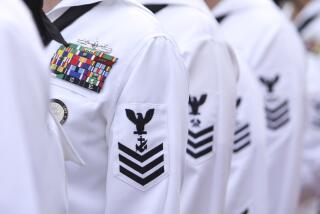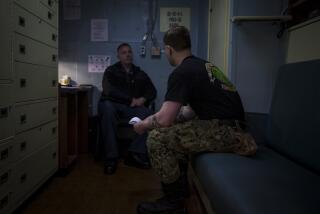Seabee Reservists Prepare for Duty
- Share via
Christopher Ricciardi doesn’t have to look far to be reminded why he is leaving his wife and 2-year-old son in San Diego for up to a year.
“This is the reason right here,” Ricciardi, 26, who is undergoing reservist training at Naval Base Ventura County, said as he pulled out a picture of his best friend, Michael D’Auria.
D’Auria, a New York City firefighter and Ricciardi’s best friend since they were in the third grade in Staten Island, N.Y., was killed when he went into one of the World Trade Center towers as it collapsed on Sept. 11.
Now Ricciardi carries the laminated funeral card--showing D’Auria smiling broadly in his uniform--wherever he goes.
Thursday, Ricciardi was standing with 149 other reservists who are training as Seabees, the naval construction crews called to hot spots around the world.
A bioterrorism class on how to don protective gear was just ending. Wearing green camouflage fatigues, the men and women crowded around Petty Officer 2nd Class Brian Dess as he showed them the quickest way in and out of a gas mask and hazardous material suit.
The exercise was among the last lessons the group of carpenters, schoolteachers and office workers will learn before shipping out over the next few days with the Navy’s Pacific Fleet.
“All we can do is give them the basics,” said Dess, who has been training the reservists since shortly after they arrived. “The longer you are here the more you think that [the training] can come in handy.”
Members of the unit live in an old converted warehouse affectionately dubbed “Hotel California.”
A partition separates the men’s sleeping quarters from the women’s. Each reservist gets a metal bunk bed with a thin mattress. They sleep on the bottom level--the top bunk is reserved for boots, clothes and duffel bags.
They will spend up to a year repairing roads, bridges and building security barriers at U.S. military and government facilities in this country and abroad, said Lt. Doug Van Cleave, 39, a civil engineer from Lake Elsinore.
The reservists are among 300 who have come through the Port Hueneme naval base since President Bush ordered the call-up in response to the September terrorist attacks and the subsequent war in Afghanistan, said Linda Wadley, a spokeswoman for the base.
“The job is to help them make the transition to the military,” Wadley said. “It’s our job to make sure they are ready to go.”
Although many in the unit have prior military service, there was still plenty of paperwork before they returned to active duty, she said.
The reservists spent days getting reacquainted with the military’s legendary and voluminous paper trails. They made out wills and checked dental and medical records.
They were fitted for new uniforms and boots and given physicals. Reservists were also instructed on assigning power of attorney to a spouse or loved one back home to take care of personal affairs.
The reservists have trained for the past two weeks in map reading, hand-to-hand combat, target practice and construction skills.
Most will be flown to their assignments over the next several days. Their destinations are kept secret.
Van Cleave, who is married and has five children under age 5, said he is not anxious to say goodbye to his family. But since the moment he watched two hijacked airliners slam into the World Trade Center towers, he has been sure he is doing the right thing.
“Everything else you just have to put on hold,” he said.
More to Read
Sign up for The Wild
We’ll help you find the best places to hike, bike and run, as well as the perfect silent spots for meditation and yoga.
You may occasionally receive promotional content from the Los Angeles Times.






